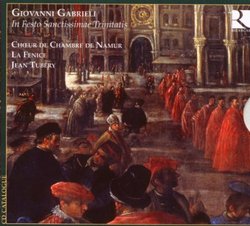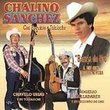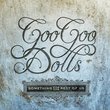| All Artists: Andrea Gabrieli, Giovanni Gabrieli, Giovanni Pierluigi da Palestrina, Jean Tubery, Ensemble la Fenice, Rosa Dominguez, Hans-Jorg Mammel, Stephan Van Dyck Title: Giovanni Gabrieli: In Festo Sanctissimae Trinitatis Members Wishing: 0 Total Copies: 0 Label: Ricercar Original Release Date: 1/1/2008 Re-Release Date: 2/12/2008 Genre: Classical Styles: Opera & Classical Vocal, Chamber Music, Forms & Genres, Toccatas, Historical Periods, Classical (c.1770-1830) Number of Discs: 1 SwapaCD Credits: 1 UPC: 5400439002593 |
Search - Andrea Gabrieli, Giovanni Gabrieli, Giovanni Pierluigi da Palestrina :: Giovanni Gabrieli: In Festo Sanctissimae Trinitatis
 | Andrea Gabrieli, Giovanni Gabrieli, Giovanni Pierluigi da Palestrina Giovanni Gabrieli: In Festo Sanctissimae Trinitatis Genre: Classical
La Fenice and the Namur Chamber Choir give a second life to the music of Gabrieli. Devoted to the Feast of the Trinity, a major event of the liturgical year at the Basilica of San Marco in Venice. Includes a full catalog o... more » |
Larger Image |
CD DetailsSynopsis
Album Description La Fenice and the Namur Chamber Choir give a second life to the music of Gabrieli. Devoted to the Feast of the Trinity, a major event of the liturgical year at the Basilica of San Marco in Venice. Includes a full catalog of the entire Ricercar 2008 collection. Similar CDs
|
CD ReviewsIt Helps to Know How It's Supposed to Sound Giordano Bruno | Wherever I am, I am. | 10/15/2008 (5 out of 5 stars) "Who else but a cornettist could ever conduct Gabrieli this perfectly? Jean Tubery is one of the Holy Trinity of cornettists alive today - Big Daddy Bruce Dickey, Groovy Kid Doron Sherwin, and Free Spirit Tubery. Dickey and Sherwin were not a part of this session, but Tubery has found two brilliant paracletes in Gebhard David and Fritjof Smith. Their three cornettos slash through the dahlia gardens of Gabrieli's polychoral motets like emerald hummingbirds. But Tubery is also a thorough musician, not just a virtuoso, and he conducts his enormous ensemble - seventeen instruments and twenty voices - with a sure sense of the distribution of the parts in order to produce a transparent whole in which the structure of the music can be heard. Balance is the key, and restraint is perhaps the keyhole. Tubery has the knack of calling forth the right phrase at the right time, and of damping down the overall uproar of three choruses and a pair of organs so that the right phrase will be heard. Aha! I've used the word "heard" at the end of two sentences in a row. It must be important. In performance of Gabrieli's complex vocal polyphony, if you can't HEAR it clearly, it's not really there.
Honestly, performing Gabrieli as something more than a big colorful ruckus is not so easy. Myself, I'd rather herd earthworms than try to conduct three choirs of voices and brass in a church. Add to that challenge the acoustic compression of recording technology and it's no wonder most Gabrieli CDs sound like synthesized mush. This is the first recorded performance of "big" Gabrieli that has ever satisfied my ears. Giovanni Gabrieli (1555-1612) is most familiar to modern audiences from performances of his "canzonas" on modern brass instruments. Hearing the same canzonas performed on cornettos and Renaissance trombones is a lot like taking off your mackinaws and galoshes on the first day of spring. 16th C trombones, by the way, had narrower bores, lighter bells, and smaller mouthpieces, and were played much more in their upper ranges, for a clearer timbre. La Fenice, Tubery's instrumental ensemble, plays six purely instrumental pieces on this CD, and illuminates the soundscape with each of them. It wasn't, however, his brass music that earned Gabrieli his huge reputation and his lucrative berth in Venice during his lifetime. Rather, it was his sacred vocal music, written to be performed in the monumental churches of Venice. This CD assembles some of Gabrieli's most festive vocal music into the kind of performance that might have been given in the splendor of St. Mark's on the Feast of the Holy Trinity, a day of ritual associated with celebration of deliverance from the plague. The vocal forces of the Chamber Choir of Namur are as responsive to Tubery's baton as the music requires. What Tubery wants from them, a kind of gilded confidence and serenity befitting Venice at its apogee of splendor, is what they give him. Can you imagine hearing Dulcis Jesu, with its 20 separate lines of polyphony, and really getting a sense of all 20 independent voices? Tubery achieves it. You can track this famous piece through multiple recordings of Gabrieli and confirm my judgment. This is an indispensable CD for lovers of the music of the era of Gabrieli, Monteverdi, and Schuetz." |

 Track Listings (15) - Disc #1
Track Listings (15) - Disc #1

